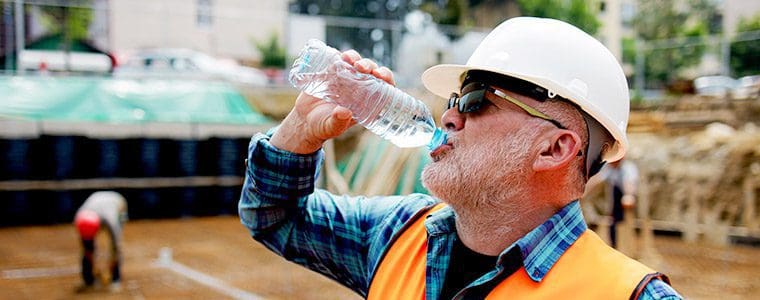Working in the Heat
Tips for Working Outside in Hot Weather
Even though it is mostly preventable, according to the EPA, heat is the leading weather-related cause of illness and death in the United States. As temperatures rise across the country, outdoor workers in general, and construction workers in particular, need to protect themselves from heat exhaustion and heat stroke. Though people of all fitness levels are susceptible to heat related stress, people with cardiovascular and respiratory diseases are more at risk, and, unfortunately, approximately one in twenty-five construction workers have been diagnosed with cardiovascular disease. Because of this, it is important for our industry to be vigilant in addressing possible heat related illnesses and educate our workforces about the ways individuals can protect themselves.

Drink Plenty of Water
One of the easiest ways to avoid heat related illnesses is to stay hydrated. It’s important when working in hot conditions to drink water even if you don’t feel thirsty. A good rule of thumb is to drink water every 20 minutes or so. Keeping a water bottle handy is an easy way to maintain hydration. OSHA regulations require employers to have potable water available free of charge at the jobsite. Make sure your water bottle is filled and ready to go when you need it.
Thinking about hydration is important both before and after a long day in the sun. Limiting dehydrating fluids such as coffee, alcohol, and drinks with excessive amounts of sugar, even when you are not at work, can help with maintaining hydration throughout the day.

Reapply Sunscreen Regularly and Wear Sun Protective Clothing
It’s easy to forget to reapply sunscreen throughout the day, but Skincancer.org recommends reapplying a sunscreen of SPF 30 or higher every two hours, with even more frequent applications if you are sweating excessively.
Although it may be tempting to wear a t-shirt and shorts when working in the heat, OSHA recommends wearing light colored, loose fitting clothing, including long sleeved shirts and long pants, along with a wide brimmed hat and sunglasses. It’s also important to remember that if you need to wear a respirator or a heavy work suit, you may be more at risk of heat related illnesses and should hydrate more frequently than you may think is necessary. Remember, thirst is not a good indicator of hydration and oftentimes, when you feel thirsty you may already be in the beginning stages of a heat related illness.

Know the Signs of Heat Exhaustion and Heat Stroke
Finally, it is important to recognize the signs and symptoms of heat related stress in yourself and others. The CDC has resources for helping people understand heat illness and provides a list of actions to help relieve and treat heat stressed individuals.
According to the CDC, the five primary types of heat illness are:
- Heat Rash
Heat rash is a condition that causes red pimple-like bumps on the skin, typically on the neck, trunk, inner elbows and groin area. - Sunburn
Sunburn causes painful reddened skin that can blister if severe. - Heat Cramps
Heat cramps are muscle cramps often accompanied by excessive sweating. - Heat Exhaustion
Signs of heat exhaustion include excessive sweating, clammy skin, tiredness, dizziness and headache. - Heat Stroke
Heat stroke is accompanied by warm reddened skin, a temperature of 103 or higher, rapid pulse, headache, dizziness, confusion, nausea/vomiting, and loss of consciousness.
Heat exhaustion and heat cramps are serious illnesses that may require medical attention, while heat stroke is the most severe heat related condition and requires immediate medical intervention.
When it comes to heat related illness, prevention is the best course of action. Drink plenty of water, take shade breaks when you need them, and dress appropriately.
Fleming Construction Group has Safely Assembled 70 Million+ Square Feet of Building Space.
Read More About Our Safety Commitment Here:


